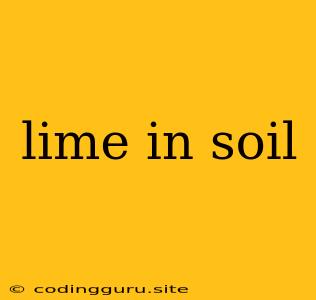Understanding Lime in Soil: A Guide to Enhancing Soil Health
Lime is a crucial element in soil management, playing a vital role in optimizing soil pH and improving overall soil health. But what exactly is lime, and why is it so important for your garden or farm? Let's delve into the world of lime and its impact on soil.
What is Lime and Why is it Important for Soil?
Lime, in the context of soil, refers to various calcium-containing materials like calcium carbonate (CaCO3), calcium oxide (CaO), and calcium hydroxide (Ca(OH)2). These materials are typically applied to soils to increase their pH, neutralizing the acidity present in the soil.
Why is pH important? Soil pH is a measure of its acidity or alkalinity. Most plants prefer a slightly acidic to neutral pH, generally between 6.0 and 7.0. Lime acts as a neutralizing agent, counteracting the acidity and bringing the pH closer to the ideal range for optimal plant growth.
Benefits of Using Lime in Soil
Improved Nutrient Availability: Lime helps unlock nutrients in the soil, making them more accessible to plants. Many essential nutrients like phosphorus, magnesium, and calcium become readily available at optimal pH levels.
Enhanced Microbial Activity: Soil microorganisms play a vital role in nutrient cycling and soil health. Lime promotes a healthy microbial population by providing a favorable environment for their growth and activity.
Reduced Toxicity: Certain elements can become toxic to plants at low pH levels. Lime helps neutralize these elements, reducing their harmful effects on plant growth.
Improved Soil Structure: Lime can help improve soil structure by promoting aggregation, making the soil less compact and better aerated.
Increased Water Infiltration: Lime's impact on soil structure enhances water infiltration and drainage, preventing waterlogging and improving water retention.
How to Use Lime in Soil
Soil Testing is Essential: Before applying lime, it's crucial to conduct a soil test to determine the current pH level and the amount of lime needed. A soil test provides valuable information on the specific needs of your soil.
Application Rates: The amount of lime to apply depends on several factors including the soil type, the desired pH, and the type of lime used. Follow the recommendations provided by your soil test or a qualified agricultural consultant.
Application Methods: Lime can be applied using various methods, including broadcasting, banding, and incorporation. Broadcasting involves spreading lime evenly over the soil surface. Banding applies lime in rows, typically along seed rows. Incorporation involves mixing lime into the soil using a tiller or other equipment.
Timing: The best time to apply lime is typically during the fall or early spring. This allows the lime to work its way into the soil before the next growing season.
Types of Lime
Calcitic Lime: This type of lime contains calcium carbonate and is the most common type used for soil amendment.
Dolomitic Lime: Dolomitic lime contains both calcium carbonate and magnesium carbonate. It is beneficial for soils deficient in magnesium.
Hydrated Lime: Hydrated lime, also known as calcium hydroxide, is a highly reactive form of lime that can raise soil pH quickly. It is often used for specific applications where a rapid pH adjustment is needed.
Conclusion
Lime is an essential tool for improving soil health, enhancing nutrient availability, and promoting plant growth. By understanding its role and using it appropriately, you can optimize soil conditions for a thriving garden or farm. Remember, soil testing is crucial to determine the specific needs of your soil and ensure you apply the correct amount of lime for optimal results.
